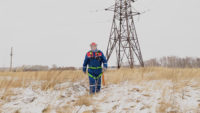How to keep your people connected and protected from heat stress

chameleonseye / iStock /Getty Images Plus
Heat stress is deadly. According to the World Health Organization (WHO), nearly half a million per year die of heat-related causes every year, making heat stress the number one cause of weather-related deaths across the globe and impacting millions of lives including those who must perform their jobs in these hot – and therefore more hazardous – work environments. As a result of its undeniable impact and threat, governments, such as the US Department of Labor , are proposing legislation and rules to “substantially reduce heat injuries, illnesses and deaths in the workplace.”
From 1992 to 2022, the US Environmental Protection Agency says almost a thousand workers died from exposure to heat, including heat stress. Heat stress encompasses several illnesses and issues that include heat stroke (fever, unconsciousness), heat cramps (painful muscle spasms/cramps, heavy sweating), heat exhaustion (dizziness, nausea) and heat rashes (painful blistering/pimples on skin, excessive sweating). Quite simply, heat stress occurs when employees work in hot environments for long periods of time or are exposed to extreme heat. As an occupational hazard, it can be a challenge to mitigate as heat stress can impact different ages and body types in varying ways. However, the dangers of working in the heat and its adverse impacts are “predictable and largely preventable,” according to the WHO, which allows employers to put proactive safety measures in place to prevent any heat-related harm to their employees in the future.
This includes a professional commitment to keep all workers in the heat this summer, connected and engaged during periods when heat stress is determined to be a risk. Particularly when alone and isolated, providing channels for communication and connection – no matter how brief – can be incredibly valuable for the person’s safety and productivity.
NIOSH recommendations
By prioritizing connection when heat stress is a risk, employers are also aligning themselves with NIOSH’s recommendations of making sure all workers and supervisors are trained in areas involving communication such as immediately reporting symptoms of heat-related illnesses, as well as established procedures for contacting emergency services.
These are in addition to their recommendations of acclimatization that gradually exposes the worker to the environment as well as specific hydration, rest breaks and engineering controls such as increased air flow in the work area. Extreme heat is a complex, deadly occupational hazard, requiring a dynamic solution and regular communication.
Train and teach
Tailored to every individual workplace, heat stress-prevention training can ensure that important safety protocols, such reporting heat stroke symptoms/remembering to take water breaks, are performed immediately, ensuring points of connection to keep the person safe. Heat stress-prevention training can help workers retain this information, keeping them more aware and engaged with their surroundings. Particularly when a person is experiencing heat stroke or heat exhaustion, they may not be able to think or communicate clearly and easy access to communication is integral.
Leverage the latest tech
The best training can lose impact without the tools and technology to keep people working in the heat connected. In addition to ubiquitous smartphones and Bluetooth/handsfree devices, employers can also provide satellite and GPS communication devices that will allow workers to report symptoms or request help, regardless of where they are working. It is very important that these devices of course properly function in hot environments and are durable and possibly water-resistant, depending on the safety needs.
Implement check-in schedule
An effective strategy to maintain connection with workers is to establish a system or schedule in which they check in with the employer verifying their safety. In work environments with high temperatures or in which they work alone, employees would be required to check in more frequently, which could be performed manually by phone and text, or an automated safety app – safety check-ins are required for its heat illness prevention program by the State of California Department of Industrial Relations.
Keep them updated
It is also incredibly important to keep employees updated with current temperatures, the heat index, heat warnings, or make sure they are aware of how to access this information. This may include internal communications and correspondence such as staff email newsletters or digital thermometers and heat-index monitors at the worksite. During periods of extreme heat, regular updates from both the worker and employer (no matter how brief) are needed to keep the person at risk safe.
More aware and engaged
A connected employee is one more aware of their safety environment and more engaged with their surroundings. This is not always possible with important tasks to focus on, however, by establishing a communication protocol and equipping them with training and technology, workers can perform their jobs to high standards, while keeping equally high safety standards at the same time.
Assess and ask
Every team working in difficult conditions, like high temperatures, communicates differently, using different systems and tools to stay safe and connected. Employers and managers must assess their work environments and ask their employees what concerns them the most. Employers must look at what the best channels are for their employees to access when they require help.
Every year, workers die from the extreme heat, and it is mostly preventable. By providing heat awareness training and safety communication technologies and devices, employers are preparing their employees before they are harmed. By thinking ahead about their safety, employers are showing that they care about their people putting themselves at risk in the hot, summer heat.
Looking for a reprint of this article?
From high-res PDFs to custom plaques, order your copy today!









